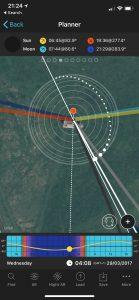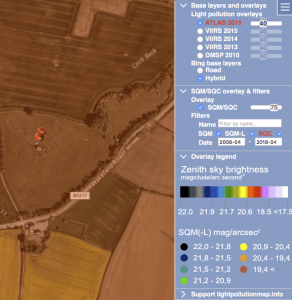One of my more popular images on Instagram has been my Milk Way Over a Pond image.
It was a rare night that was clear with the Milky Way positioned exactly where I wanted it with no moon in the sky.
As mentioned in a previous post, I use PhotoPills for my Milky Way shoot calculations, if you have an iPhone/iPad, check it out, it has to be one of the best all-in-one photography apps I have seen.
As you can see from the PhotoPills app, I could see that the Milky Way was going to be rising over the pond (pond not shown on the image, as Google hasn’t updated it’s aerial photography).
I was shooting with a full frame Sony a99 and a Zeiss 16-35mm f2.8 lens, so I positioned myself to make sure that the camera was high enough that I could get reflections in the pond, but also so that I could get plenty of the sky in frame.
Once in position and properly framed, I then took to PhotoPills again, to calculate my maximum exposure to get stars without trails with minimal ISO noise.
There is a straight forward rule for calculating this, and it is called the 500 rule (or 600 rule if you know what the minimum declination is of the stars). As a rule of thumb, the 500 rule is sufficient, and looks like this:
500/[focal length*sensor crop]=[max exposure]seconds
so in my case:
500/16mm=31.25 seconds
To make sure that there are no trails I also rounded down the exposure to 25 seconds. Instead of trying to do the calculations at the time, PhotoPills has a part of the app that will do the calculation for you. Just set your camera (will take crop sensors into account), the lens focal length and minimum star declination angle (if known). PhotoPills will then tell you what the maximum exposure will be using the 500 rule (and 600 rule if you know what the angle of the stars is).
To let as much light in as possible it is always advisable to use the widest aperture your lens will support, in my case it was f2.8. From there it was a case of finding the optimum ISO with a 25 second exposure and an aperture of f2.8, low enough to give minimal noise, but high enough that there was sufficient detail in shadows and dark areas of sky. For most cameras this ISO is between 3200 and 6400, and the type and quality of sensor determines what you can get away with. If you have too high ISO you will find that the pin points of stars turn into blurry blobs as definition is lost, but too low ISO and it will be very difficult to recover the shadows without introducing noise. In this instance, with no moon in the sky and very little light pollution, I had to push my camera sensor to ISO 6400 to get a reasonable exposure. You will notice that with the time of year the sun is barely below the sky, and from previous experience I have found that too long exposure will end up with a very bright horizon with the sky being dark as the sensor picks up light leaking over the horizon. Camera sensors record much more detail that you normally see, which means that the image that comes out of a Milky Way shot is not normally anything like the finished product. There is a lot of pushing and pulling of contrast and details in post processing, so it is important that your lens and sensor are both clean, check this before taking Milky Way images.
As always, if you have any comments, or would like more information about this image, then please let me know below, I am always happy to hear from my readers. Don’t forget to subscribe to the RSS feed to be notified when new blog posts are published.
Here is the final image, Milky Way over a pond:
 Sony Alpha99, Zeiss 16-35mm 2.8 @ 25 seconds, ISO 6400 F2.8
Sony Alpha99, Zeiss 16-35mm 2.8 @ 25 seconds, ISO 6400 F2.8


